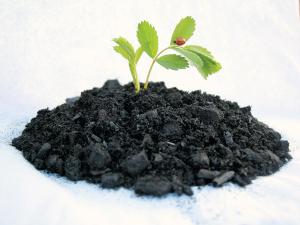Add charcoal to create rich, quality garden soil
Gardeners must always look ahead. For years, scientists thought of the Amazon River basin as a pristine land untouched by humans with the exception of a few small bands of hunter gatherers. They thought the thin tropical soil was useless for agriculture.
However early Portuguese explorers found areas of rich black earth they called “terra preta do indio,” meaning "Indian black earth" in Portuguese. The pre-Columbian peoples created this rich soil by adding charcoal and animal bones to regular dirt to produce a very fertile soil. When organic material is burned without oxygen, the result is charcoal.
You can do the same with your own garden or farm soil by adding the single vital ingredient of terra preta, charcoal. When used in soil building, charcoal is often referred to as “biochar.”
Biochar can decrease nutrient leaching, lower soil acidity, and reduce the amount of water and fertilizer used on your vegetables and flowers. Charcoal is highly porous and contains many of the nutrients found in the organic material from which it was made. Charcoal increases the soil’s ability to hold onto plant nutrients and beneficial soil microbes by slowing or reducing the leaching of nutrients by rain or watering.
The low density of charcoal lightens heavy soils, which allows better root growth, increasing drainage and allowing air into the soil. Charcoal works the same as agricultural lime to raise soil pH. This all-natural product increases soil levels of available calcium, magnesium, phosphorus and potassium.
You can make your own garden charcoal or biochar. Do this on a calm day with no wind. Because you will use live fire, always have a fire extinguisher handy.
Dig a small trench or hole in your garden or field. Loosen the soil in the bottom of the hole or trench. Add dried leaves, sticks, brush, or any other organic matter to the hole. Start small so you can control the fire.
Set fire to your dried material. Bear in mind that this will go into your soil; never use charcoal lighter, gasoline or other chemicals on the fire.
You want the fire to burn hot and fast at first, and after the initial flames die down a little, bury the pile with dirt to cut off the oxygen. Your trench or hole will now smolder and slowly burn. Keep an eye on it and once the larger pieces are about three inches big, put the fire out completely with plain water. Be sure the fire is completely out. Let the embers cool off completely before adding this charcoal to the soil. Pulverize the charcoal until it is in pieces the size of a pea or smaller. To crush the charcoal, put it in a heavy sack and beat it with a broom handle, baseball bat, or two-by-four piece of wood. Use your charcoal or biochar the same way you use compost or manure. Scatter it lightly across the soil and work it in. You can even add fine charcoal to your compost heap to speed up the composting process. Always use charcoal or biochar with fertilizer or naturally rich soil, or you may slow down plant growth.
Charcoal captures carbon and prevents its release into the atmosphere. Charcoal can retain its carbon in the soil for up to 50,000 years. Thanks to the so-called primitive people of the Amazon, charcoal in the garden can help increase crop yields, reduce water runoff, and let us breathe easier for a long time. Maybe 50,000 years.




















































